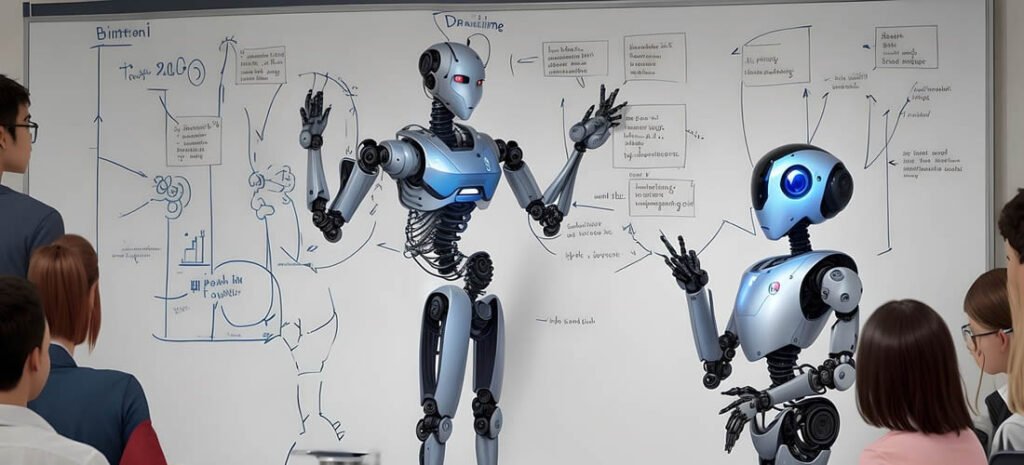Self-regulated learning refers to the process where learners actively initiate their own learning paths, applying strategies to achieve their learning objectives. Engaging in self-regulated learning means that you’re in full control of your learning process, setting goals, planning your study time, choosing effective strategies, and self-evaluating your progress.
The importance of self-regulated learning cannot be underestimated, particularly in terms of personal and academic growth. Not only does it foster a deep, intrinsic understanding of subjects, but it also boosts confidence and independence. By adopting a self-regulated approach, you can better manage your learning pace and style, ensuring that studies are aligned with personal needs and preferences. Moreover, these skills go beyond the academic realm, equipping learners with the resilience and adaptability required in lifelong learning and professional development.
The Self-Regulated Learning Process
Self-Regulated Learning (SRL) is a dynamic, interactive process that involves the following steps:
- Goal Setting: You start by identifying what you want to learn or achieve. This could be a specific skill, knowledge area, or performance level.
- Planning: Next, you devise a plan that outlines the actions needed to reach the goal. This could include choosing the learning resources, scheduling study sessions, and breaking down the goal into manageable tasks.
- Strategies: You then select and use learning strategies that best suit your learning style and the task at hand. These strategies could involve mnemonic devices, note-taking, self-testing, or concept mapping.
- Monitoring: Throughout the learning process, you need to monitor your progress towards achieving the goal. This involves self-assessment, feedback-seeking, and adjusting your strategies as needed.
- Evaluation: Finally, you evaluate the outcomes of your learning process. Did you reach the goal? What worked well? What could be improved for future learning tasks?
Core Concepts of Self-Regulated Learning
Self-regulated learning is a journey that you, as a learner, undertake; it’s about taking ownership and directing your own learning process. This concept primarily revolves around three core components: cognition, metacognition, and motivation.
Cognition refers to the mental processes involved in gaining knowledge and understanding. It’s the bedrock of learning, including skills such as reading comprehension, problem-solving, and memorization.
Metacognition, on the other hand, is your ability to “think about your thinking.” It’s an eagle-eye view of your own learning process, where you monitor, assess, and regulate your cognitive activities. It’s about being aware of your learning styles, strengths, and weaknesses, and using that understanding to improve your learning outcomes.
Lastly, motivation is the driving force behind self-regulated learning. It’s about your beliefs, values, and goals related to learning. When you are intrinsically motivated, you engage in learning for the sheer joy of it, making the learning outcome more effective and rewarding.
Self-Regulated Learning Strategies
Metacognitive Strategies
1. Goal Setting and Planning
Goal setting and planning are integral parts of Self-Regulated Learning (SRL). As a learner, it’s crucial that you clearly define what you wish to achieve. This can range from mastering a new skill to understanding a complex concept. The clearer and more specific your goals, the easier it is to strategize how to reach them.
Planning, on the other hand, entails laying out a roadmap to your goals. It involves determining what needs to be done, when, and how. When you plan, you’re actively deciding on the steps and resources necessary to achieve your objectives. This process not only makes the journey towards your goals less overwhelming but also promotes time management and prioritization skills.
2. Self-monitoring and reflection
Self-monitoring and reflection is a key strategy in Self-Regulated Learning. As you progress through your learning journey, it’s crucial to regularly monitor and reflect on your understanding of the material. This involves asking yourself questions such as, “Do I understand this concept?”, “Am I able to explain this to someone else?”, or “How can I apply this knowledge in a practical setting?”
Reflecting on these questions allows you to identify areas of strength and weakness, and adjust your study strategies accordingly. This continuous cycle of self-monitoring and reflection enhances your learning efficiency, making you an active participant in your own education.
3. Time management and organization
Time management and organization are integral facets of Self-Regulated Learning. By effectively managing your time, you’re not just avoiding the last-minute rush; you’re taking control of your learning process. Planning ahead allows you to allocate adequate time for each task, reducing stress and enhancing your understanding of the material.
Similarly, organization skills play a critical role. When your study materials are neatly arranged and easily accessible, you can swiftly navigate through different subjects and topics. This not only streamlines your learning but also makes it more enjoyable. Remember, a well-organized study space can significantly improve your productivity, fostering a conducive environment for effective self-regulated learning.
Motivational Strategies
4. Intrinsic vs. extrinsic motivation
When it comes to self-regulated learning, understanding the concept of intrinsic vs. extrinsic motivation is paramount. Intrinsic motivation comes from within you; it’s driven by personal interest, curiosity or love for the subject. This is the force that makes you learn a new language because you love how it sounds, read a book because you’re genuinely interested in the topic, or solve a puzzle because you enjoy the challenge.
On the other side of the coin, extrinsic motivation is influenced by external factors such as rewards, grades, or praise. In this case, you might find yourself studying hard to score high on a test, not because you’re intrigued by the subject matter, but because you’re chasing a good grade.
Both types of motivation play a role in self-regulated learning. Leveraging intrinsic motivation tends to foster a deeper, more enduring learning experience as it is tied to personal fulfillment. However, extrinsic motivators cannot be discounted as they can serve as a necessary push at times, especially in areas where intrinsic motivation may be lacking. Balancing both types of motivation can help you to take command of your learning journey effectively.
5. Finding your sources of motivation
Finding your sources of motivation is an integral part of self-regulated learning. You see, motivation isn’t a one-size-fits-all concept; it varies for each individual. What drives one person may not necessarily drive another. As a learner, it’s essential to identify what truly motivates you. Is it the thrill of gaining new knowledge? The satisfaction of mastering a challenging topic?
Or perhaps the potential rewards of academic success? Once you’ve identified your unique sources of motivation, you can use them as a fuel to keep the engine of your learning journey running. When the road gets tough, remind yourself of these motivations and allow them to guide you back on track. This is a powerful strategy for maintaining your momentum in self-regulated learning.
6. Overcoming procrastination
Overcoming procrastination is a vital Self-Regulated Learning strategy that can significantly enhance your productivity and learning efficiency. It’s all about gaining control over your actions and ensuring that they’re aligned with your academic or professional goals. Procrastination often stems from the challenging nature of a task or a lack of clear direction, resulting in avoidance. But you have the power to change this.
Start by breaking your tasks into manageable chunks and establishing a realistic timeline for completion. Use tools like planners or digital apps to keep track of your progress. Reward yourself upon achieving each milestone – this not only boosts motivation but also reinforces positive behavior.
Overcoming procrastination isn’t about being perfect; it’s about being better than you were yesterday. With time and practice, this self-regulated learning strategy can become an integral part of your work habit, steering you towards success.
Behavioral Strategies
7. Active learning techniques
Active learning techniques are pivotal strategies in self-regulated learning, empowering you to take charge of your educational journey. Instead of passively absorbing information, you interact with the material, making the learning process dynamic and engaging. Techniques such as summarizing information in your own words, teaching someone else, or even engaging in group discussions can consolidate your understanding and recall of the content.
This active participation helps you to identify any gaps in your knowledge, thus enabling you to seek clarification and deepen your understanding. Remember, the objective is to be proactive in your learning, continually assessing your progress, and applying strategies that enhance your comprehension and retention. Active learning is not just about knowing; it’s about understanding and applying.
8. Note-taking methods
Note-taking is an essential part of the self-regulated learning strategy. As you interact with new information, jotting down key points helps to reinforce your understanding and retention. It’s not just about blindly transcribing what you hear or read; it’s about actively processing the content and summarizing it in your own words.
There are several effective methods you can adopt, such as the Cornell System, which divides the note page into three sections: cues, notes, and a summary, or the Outlining method, which structures notes into main ideas and supporting details.
Mind Mapping, another popular approach, uses diagrams to represent words or ideas related to a central concept. Through these methods, note-taking allows you to engage with material in a deeper, more personalized way, enhancing your self-regulated learning journey.
9. Effective reading strategies
As you venture into the realm of self-regulated learning, effective reading strategies form a crucial part of your toolkit. Now, you might wonder, what makes a reading strategy effective? It’s not just about understanding the words on a page, but about active engagement with the content.
Start by previewing the material, looking over the headings, subheadings, and any highlighted or bolded information. This initial scan gives you a roadmap of what to expect and helps to focus your mind on the material at hand.
During the reading phase, make it a habit to take notes and summarize sections in your own words. This not only ensures comprehension but also reinforces the material in your mind. Another effective strategy is questioning — asking yourself questions about what you’ve just read or predicting what might come next.
Finally, review what you’ve read, reflecting on the main ideas and how they connect to what you already know. Remember, effective reading isn’t a passive activity but an interactive process that involves preparation, comprehension, and reflection.
10. Utilizing technology for learning
Utilizing technology for learning is a potent self-regulated learning strategy that you can harness. In this digital age, technology provides an array of resources right at your fingertips. From online courses to interactive educational apps and digital textbooks, technology transcends traditional education boundaries, allowing you to take control of your learning trajectory.
With these resources, you can set your learning pace, choose your focus areas, and revisit concepts until you’ve fully grasped them. In essence, technology empowers you to own your learning journey, making it a highly effective self-regulated learning strategy.
Consider, for example, you’re studying for an upcoming exam. Instead of solely relying on textbooks, you can utilize technology as part of your self-regulated learning strategy. You can leverage online platforms like Quizlet to create digital flashcards that help you memorize important information.
You might also use an app like Evernote to organize your notes efficiently and ensure that you’re covering all the necessary topics. Youtube can serve as an excellent resource for explanatory videos that provide a different perspective or more in-depth understanding of complex topics. By actively choosing and using these tools, you’re taking control of your learning process, demonstrating the essence of self-regulated learning.
Conclusion
Mastering self-regulated learning strategies is not just about acing your exams or tests. It’s about empowering you to take charge of your own learning journey. It involves understanding and harnessing your strengths, acknowledging and working on your weaknesses, and continuously adapting your learning strategies to suit your evolving needs. Remember, the key to self-regulated learning is persistence. Yes, it may seem challenging at first, but as you become more practiced, you’ll find that you’re not only learning more effectively, but also discovering the joy in the process of learning itself.
You might also like:
- 13 Alternative Learning Methods for Effective Learning
- Experiential Learning in Action: 8 Practical Strategies for Success






